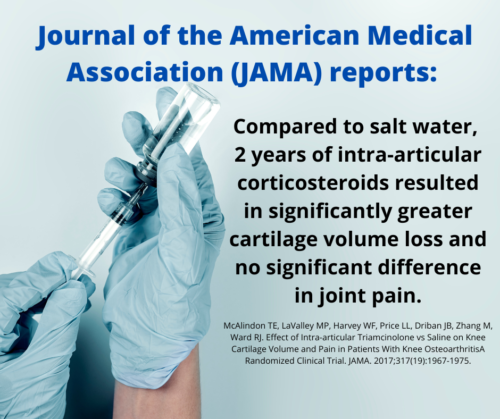
Cortisone shots are a common treatment option for joint pain relief. But are these injections a good course of action? Many times they are not! Even though cortisone injections are frequently recommended, they have an adverse effect on the bone and soft tissue healing.
Cortisone shots, or corticosteroid injections, inactivate vitamin D. That means they limit calcium absorption by the gastrointestinal tract, which decreases calcium uptake for the bone. This process will ultimately lead to weakness in the bone.
Additionally, corticosteroids inhibit the release of growth hormones. What does that mean? The decrease in growth hormone will interfere with soft tissue and bone repair. The result is an overall decrease in the strength of the bones, ligaments, and tendons.
Furthermore, corticosteroids inhibit chondrocyte production. Chondrocytes are the cells responsible for cartilage formation. Therefore, corticosteroids interfere with the formation of cartilage, collagen, and even blood vessel formation.
The medical journal Radiology lists the side effects of cortisone injections in an article called “Intra-articular Corticosteroid Injections in the Hip and Knee: Perhaps Not as Safe as We Thought?”.1 The article states that the side effects of cortisone injections include:
The study’s lead researcher found that “corticosteroid injections may be associated with complications that potentially accelerate the destruction of the joint and may hasten the need for total hip and knee replacements.” He also says, “We’ve been telling patients that even if these injections don’t relieve your pain, they’re not going to hurt you.” But that is not really true. He says, “But now we suspect this is not necessarily the case.”1
The researcher continues, “Physicians do not commonly tell patients about the possibility of joint collapse or subchondral insufficiency fractures that may lead to earlier total hip or knee replacement,” “This information should be part of the consent when you inject patients with intra-articular corticosteroids.”
With this information, it would seem then that even one injection should be avoided if possible.
Some people do get relief from cortisone. But not all people do! And corticosteroid injections have been used for a very long time. Their anti-inflammatory and pain relief properties made their use a common practice within the medical community.
However, the same properties that make them effective in decreasing inflammation and pain are the same properties that lead to the destruction of cartilage.
In 2017, an article in the Journal of the American Medical Association (JAMA) asks the question, “What are the effects of intra-articular injection of 40 mg of triamcinolone acetonide every three months on the progression of cartilage loss and knee pain in patients with osteoarthritis?”2
The answer: “Among patients with symptomatic knee osteoarthritis, two years of intra-articular triamcinolone, compared with intra-articular saline, resulted in significantly greater cartilage volume loss and no significant difference in knee pain. These findings do not support this treatment for patients with symptomatic knee osteoarthritis.”2
So what is the alternative to cortisone, considering pain relief is still necessary? That’s where Regenerative Orthopedics comes in! Treatments like Stem Cell Therapy, PRP, and Prolotherapy work to actually repair the arthritic joint. They don’t just cover up the pain as many other treatments do. These treatments provide pain relief. They actually heal the joints, strengthen the structures of the joints, and even boost the growth of cartilage.
Regenerative Orthopedics regenerates the joint rather than causing degeneration like what occurs with cortisone injections. There is also minimal downtime needed when receiving these regenerative treatments. That means you can continue to exercise and move the joint, which is essential for a healthy joint. Exercise helps ease pain, improve mobility, and strengthen muscles around the joints.
Regenerative Orthopedics is the treatment of choice to achieve the pain relief you desire while returning function to your painful joint and helping you to once again participate in the activities you enjoy.
1Kompel AJ, Roemer FW, Murakami AM, Diaz LE, Crema MD, Guermazi A. Intra-articular Corticosteroid Injections in the Hip and Knee: Perhaps Not as Safe as We Thought? Radiology, 2019; 190341
2McAlindon TE, LaValley MP, Harvey WF, Price LL, Driban JB, Zhang M, Ward RJ. Effect of Intra-articular Triamcinolone vs Saline on Knee Cartilage Volume and Pain in Patients With Knee OsteoarthritisA Randomized Clinical Trial. JAMA. 2017;317(19):1967-1975.